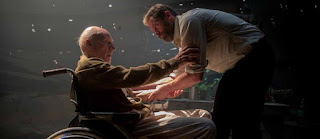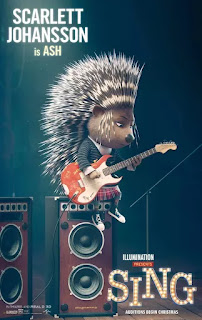WRITER'S NOTE: This post is Part 2 of my list of films from 2016 (you can read Part 1
here). Also, while there were some films I regretted not seeing in theaters last year (particularly
A Monster Calls,
Paterson, and
Silence), I will more than likely be updating my lists for "Films of the Decade" for the 2010s in the months to come.
As I've said before, the following selections and reviews aren't necessarily a means of recommendation nor an endorsement for the worldviews in these films. Rather, they are selected based on their artistic and thematic qualities, their worthy critique, and their universal appeal.
And lastly, not all of the films on this list received full reviews by yours truly. (No excuses.) Wherever mentioned, click the links below to read my reviews for the respected films.
***
Before I reveal my top picks for 2016, here are some "Notable Mentions":
Hidden Figures
A remarkable untold true story of African-American mathematicians involved in NASA's space program in the 1960s, and their determination and willingness to persevere in a time of racial and civil divide. Backed by top-notch performances from Taraji P. Henson, Octavia Spencer, Janelle Monae, and Kevin Costner, and music by Pharrell Williams, this is a story for inspiring figures who don't ordinarily get the recognition they deserve. (Read my review
here.)
The Jungle Book
Disney continues its streak of successful live-action adaptations of classic stories (and their own animated versions of said stories) with this new take on Rudyard Kipling's classic book. A visual marvel with a stellar voice cast, worthwhile themes, and emotional resonance--the "bare necessities" of such a worthy film.
Lion
A powerful and remarkable true story of Saroo Bierkly, an Indian boy adopted into an Australian family after wandering from home, who sets out on a journey, as a young man, to find his biological family. Moments of sensuality aside, this is a moving story of adoption, memory, and family. Dev Patel and Nicole Kidman give two of the year's best performances. (Read my review
here.)
Rogue One: A Star Wars Story
A standalone feature that works on its own (while fitting itself into the
Star Wars canon). Set prior to the events of the 1977 original film, a group of rebel fighters (including a scene-stealing K-2 droid) seek to steal the plans for the Death Star and restore hope to the galaxy. Unlike anything seen in the franchise before. (Read my review
here.)
Sing
While not as deep as
Zootopia or
Kubo, this crowd-pleasing music romp with anthropomorphic animals in a singing competition is a lot of fun. It also ends a year full of many unexpected celebrity passings on a high (and subtly, if unintentionally, commemorative) note. Favorite characters: porcupine punk-rocker Ash (Scarlet Johansson), shy-and-soulful elephant Meena (Tori Kelly), and gorilla Johnny (Taron Egerton). (Read my review
here.)
***
And now, here are my picks for the ten standout films of 2016:
10.
Fences
Denzel Washington directs and headlines this big screen adaptation of August Wilson's Pulitzer Prize winning play set in 1950s Pittsburgh, as family patriarch Troy Maxson (Washington) struggles against the times he's living in, those behind him, and those closest to him. A riveting and provocative film, with Washington and Viola Davis (as Troy's devastated wife, Rose) delivering powerful and well-deserved performances. (Read my review
here.)
9.
Jackie
Natalie Portman shines in this vivid and complex portrait (and dramatization) of American icon Jacqueline Kennedy in the wake of an unexpected tragedy (the assassination of JFK), while also chronicling her week-long transition into a new chapter in American history. Unconventional in its filmmaking approach yet emotional and meditative in its resonance. (Read my review
here.)
8.
Hacksaw Ridge
Director Mel Gibson makes an unexpected comeback with this graphic and incredible true story of real-life WWII private Desmond Doss, the first conscientious objector at the frontline of battle who refused to carry or fire a weapon in one of the bloodiest battles in world history. A character study that honors its hero's legacy and those who've served, while challenging and inspiring the notion of what it means to be a hero. (Read my review
here.)
7.
Sully
Director Clint Eastwood and star Tom Hanks team up to tell the story of American pilot Capt. Chesley "Sully" Sullenberger and the Miracle on the Hudson, and the untold story of the investigation that followed. Filmed with IMAX cameras that brilliantly recreate the now-famous landing, this is another film this year that evokes and challenges the definition of what a hero is. Hanks is every bit the everyman he's great at playing, and yet still delivers a performance of subtlety, conflict, and quiet determination. (Read my review
here.)
6.
Kubo and the Two Strings
Laika Animation delivers their magnum opus in their repertoire of stop-motion animated features. Only instead of angst-ridden teenagers crawling through doors to alternate realities (
Coraline), or kids seeing zombies and ghosts (
ParaNorman), or a steampunk Victorian setting (
The Boxtrolls),
Kubo features a boy warrior in fugal Japan on a journey to find the armor of his late Samurai father. Accompanied by a monkey and beetle (Charlize Theron and Matthew McConaughey, respectfully), this film delivers breathtaking visuals and unexpected depth and drama that mark it as one of the year's most amazing achievements.
5.
Captain America: Civil War
The Marvel Cinematic Universe takes the beginning of its third phase in a different route as the worldviews of various Avengers (particularly Steve Rogers/Captain America and Tony Stark/Iron Man) turn against each other while world leaders try to keep them in check after a series of catastrophic global events. The Russo brothers strike a balance here in making this third Captain America story (or, more appropriately,
Avengers 2.5) both a conflicting character study as well as a summer popcorn muncher. I mean, it features one of the best action sequences in the history of comic book movies, for crying out loud! Plus, Black Panther and Spider-Man steal the show. (Read my review
here.)
4.
Arrival
What seems like another alien invasion epic a la
Independence Day or
District 9 is actually an unconventional science-fiction drama about first contact and human connection. Amy Adams gives perhaps her best performance to date as a linguist who makes contact with alien beings and who goes through a realm of time and memory. With excellent acting support from Jeremy Renner and Forest Whitaker, as well as the striking imagery of egg-like ships hovering around the world, this is a remarkable and thought-provoking achievement that redefines the whole genre.
3.
Zootopia
Disney Animation delivers their most original story in years. Set in the anthropomorphic animal kingdom (an unprecedented visual achievement in and of itself!), an ambitious bunny cop named Judy Hopps tries to solve a case with the help of a sly fox, Nick Wilde. Clever gags (the scene with the
sloths at the DMV is a riot), deep thematic storytelling, societal undertones (prey vs. predator) and winning characters take Disney Animation to a whole other level.
Zootopia is terrific.
2.
Midnight Special
Director Jeff Nichols' sci-fi drama about a young boy with extraterrestrial powers pursued by FBI agents and religious extremists (you could say it's a feature length version of M83's "Wait"
music video) is another exceptional and redefining entry (though an underappreciated one) in the science-fiction genre. Superb acting from Michael Shannon, Joel Edgerton, Kirsten Dunst, Adam Driver and Sam Shephard, and a very human and provocative story of faith, family, and the unknown. (Read my combined review for this film and
Arrival here.)
1.
La La Land
Writer-director Damien Chazelle follows up (and counters) his intense and nerve-wracking sophomore hit
Whiplash (2014) with a musical for people who don't love musicals. Featuring
Ryan Gosling and Emma Stone as two dreamers in modern-day Los Angeles,
La La Land is an irresistible, song-and-dance extravaganza. A rare treat that balances a journey that reaches for the stars and yet grounds itself in reality brilliantly. A well-deserved award-winner with unforgettable vibes. (Read my review
here.)









































